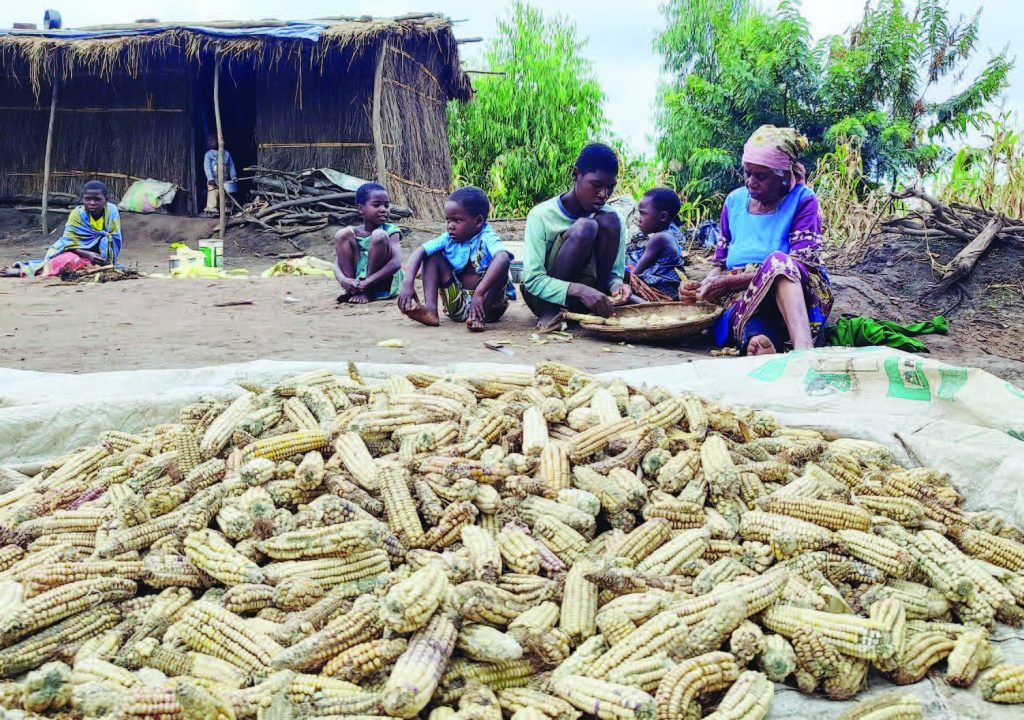More than 600 people have been killed by Cyclone Freddy, which washed away homes, roads and crops in Southern Malawi last month.
Grace Joseph’s maize looked good until the longest-lasting cyclone struck again with more devastating effect than its first touchdown in February.

About 659 000 people have been displaced in the 13 districts.
“As it stands, I will have to continue being dependent on food aid,” says Joseph, 62.
After a poor crop last year, she hoped for a decent harvest to feed her family.
From storms to drought, farmers in Malawi have faced frequent climate-related disasters thatdeepen hunger and poverty in the country, where cyclones Ana and Gombe affected about one million people last year.
says Senior Chief Malemia of Nsanje: “Just as the people were recovering from that experience, Freddy has washed away all what they hoped for. It’s now hard to imagine how these people will survive.”
Densely populated and agriculture-dependent, Malawi is extremely vulnerable to climate change.
Experts urge the authorities to rethink their agricultural policies and find “climate-smart” alternatives to better insulate smallholder farmers from climate shocks.
Unpredictable weather already makes it difficult for rural producers to feed themselves and get surplus for sale.
In the previous farming season, storms, followed by dry spells, reduced maize yield by almost 19 percent to 3.7 million metric tonnes, down from the proceeding season’s 4.6 million.
Even before Freddy struck, this year’s harvest was expected to be below average due to prior poor rainfall and the rocketing global cost of fertiliser. Regularly, over half of Malawian families are deemed food insecure, with 3.8 million people requiring food aid during the ongoing lean season from October to March.
Since the 1970s, government has tried to boost maize yields of rain-dependent subsistence farmers by subsidising fertiliser and improved seed.
But costs have spiralled of the subsidy, raising concerns over its sustainability.
According to a study by the International Food Policy Research Institute (Ifpri), it is now cheaper for Malawi to import maize than the fertiliser.
Last year, an expanded Affordable Inputs Programme (AIP) swallowed 85 percent of the agriculture budget, crowding out expenditure on irrigation and other much-needed farmer support services.
Rising global fertiliser prices forced the government to trim the number of target farmers from the planned 3.7 million to 2.5 million.
But the overall mismanagement of the AIP has also been a challenge. These include the logistical headache of getting fertiliser and seeds on time for farmers to plant with the first rains; poor farmers’tendency to sell the low-cost inputs; and corruption within the system.
Last year, President Lazarus Chakwera promised reforms to better target and supply the needy farmers.
“We need to have a better solution for such citizens [affected by food insecurity] rather than condemning them to a life of dependency on a programme that is not suited for them,” he said.
But little has been done to tackle the broader structural issues that have failed to lift subsistence farmers out of poverty.
For the poorest farmers, direct cash transfers could be a better solution, according to IFPRI.
The subsidy programmes distribute chemical fertilisers that deplete soil nutrients over time, leaving farmersrequiring more fertiliser each year to yield more.
However, more sustainable organic fertilisers improve soil structure, reducing crop failure during dry spells.
The government uses maize production to measure success, yet its rain-dependent farmers remain extremely susceptible to dry spellsand the crop is not suitable for some agricultural zones.
Critics say politics sustains the subsidy programmes and gets in the way of reform.
It is deemed a vote-winner among the rural electorate and a “cash cow” for agribusiness.
This is part of “deeply entrenched rent-seeking tendencies” that have plagued subsidy schemes since the late 1990s, notes researcher Blessings Chinsinga.
More than 70 percent of farmers in Malawi produce little more than a subsistence crop on less than a hectare of land due to erratic weather, declining soil fertility, weak markets and limited use of new technologies.
Confronted by the looming climate crisis, just getting more inputs to farmers on time is not the answer.
“Adaptation is the only solution,” says agricultural expert Tamani Nkhono Mvula.
This includes an aggressive promotion of ‘climate-smart’ agriculture to help farmers adjust to the inevitability of higher temperatures and more variable rainfall.
But conservation farming, based on improved land and water use management, is practised on just two percent of cultivated land.
Although the government formally recognises the need for adaptation, implementation, financing and policy coordination remain problematic.
“The agenda [for climate-smart agriculture] is mostly driven by international non-governmental organisations rather than the national government,” the World Bank reports.
Zhijun Chen, representative of the UN’s Food and Agriculture Organisation, states: “There is a need to facilitate upscaling and implementation of adaptation practices at the community level to enhance resilience, as well as availing climate information to help farmers make timely and informed livelihood decisions.”
To do that, the government needs to spend far more than it currently does on agricultural extension officers, noted Civil Society Agriculture Network executive director Lilian Saka.
Malawi also needs to halt land degradation and forest loss.
Without these investments to jumpstart adaptation, climate change could reduce Malawi’s gross domestic product by up to nine percent by 2030 and 20 percent by 2040. This would trap farmers like Joseph in an unending poverty.
Source: The Nation_Monday, April 16, 2023_By Madalitso Kateta
